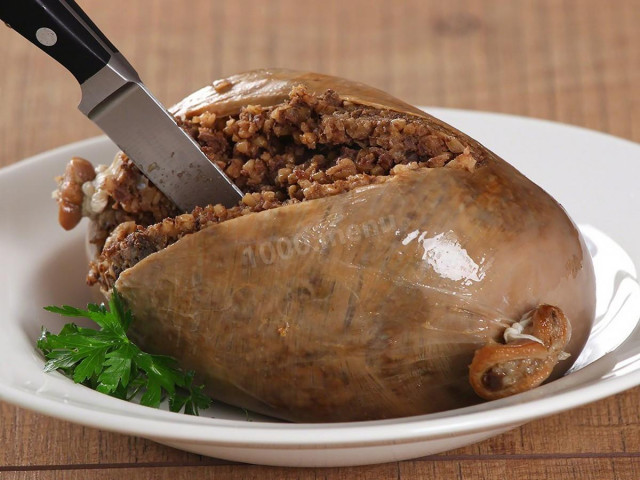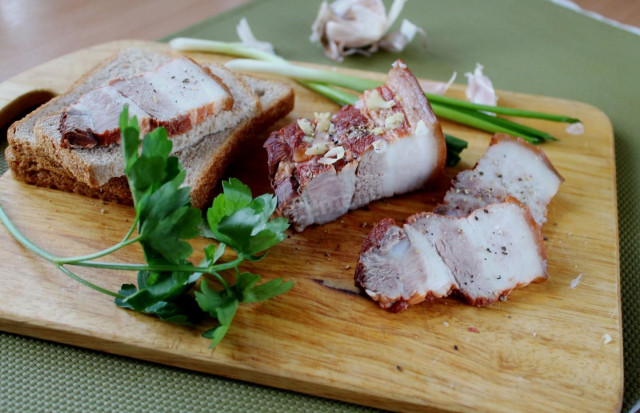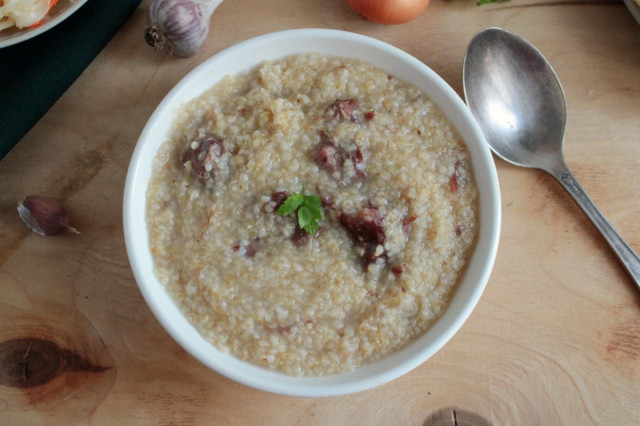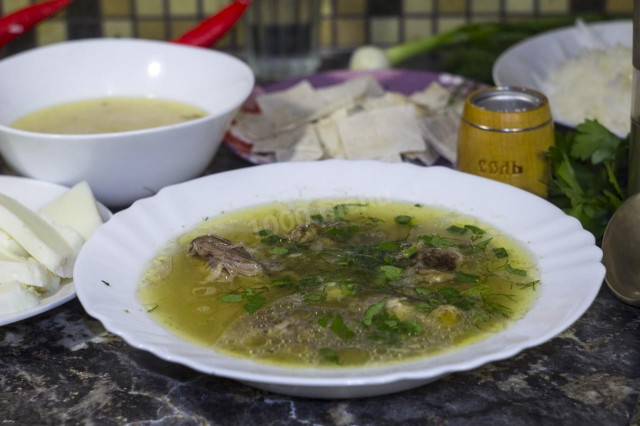Composition / ingredients
Cooking method
The principle of cooking haggis is not as complicated as it may seem at first. By and large, offal can be taken pork, beef, lamb. The latter are a priority, so ideally haggis is prepared from them. But since it is easier to get pork offal, we will prepare a dish from them. The principle is the same.
1. My stomach is thoroughly washed under running water. We spread it on the work surface, remove excess fat, mucus and films. We turn it inside out and do the same from the inside. Re-wash my stomach.
2. Pour cold water into a bowl, pour vinegar here and add salt, mix. We put the prepared stomach into the resulting solution, leave it for 8 hours (the easiest way is to prepare the stomach in the evening and leave it in the solution overnight).
3. Pour the oatmeal into a separate bowl, fill with cold water, leave to swell for 4 hours.
4. The heart is also cleaned of fatty deposits, the liver and lung are prepared accordingly. All by-products should be thoroughly cleaned of excess fat, films, veins, blood clots. Then my heart, liver and lung are under running water.
5. We put the offal in a saucepan and pour water so that it completely covers them. We send it to the fire, cook for two hours on low heat. Do not forget to add salt to taste.
6. Boiled giblets are removed from the broth, cooled, then cut as small as possible, put in a large bowl. Peel the onion, cut into small cubes, add it here. After the onion, we send the oatmeal into a bowl. We enrich it with spices: ground red and black pepper, nutmeg, coriander, sea salt. Pour the broth (one glass will be quite enough, it's 200 ml). Mix everything thoroughly.
7. With the prepared composition, we fill the stomach with 2/3 of the total volume. It is not necessary to tamper strongly, since when cooking the oatmeal will swell, and the stomach itself will tighten a little. The opening of the stomach is sewn up, and in several places we pierce the walls with a needle so that during the cooking process there is a place for air to escape.
8. Well, we place the stomach in a saucepan, pour the broth in which the giblets were cooked, send it to a minimum fire, cook for 3 hours.
We serve haggis on the table hot. It is usually served on a common dish, making a cross-shaped incision with a knife, and those sitting at the table put the contents on their plate. As a side dish, you can serve mashed potatoes, but this is optional.
Bon appetit!
Calorie content of the products possible in the composition of the dish
- Ground black pepper - 255 kcal/100g
- Wine vinegar (3%) - 9 kcal/100g
- Vinegar 9% - 11 kcal/100g
- Balsamic vinegar - 88 kcal/100g
- Apple vinegar - 14 kcal/100g
- Vinegar - 11 kcal/100g
- Oatmeal - 374 kcal/100g
- Boiled hercules - 91 kcal/100g
- Salt - 0 kcal/100g
- Water - 0 kcal/100g
- Onion - 41 kcal/100g
- Ground red pepper - 318 kcal/100g
- Sea salt - 0 kcal/100g
- Ground coriander - 25 kcal/100g
- Lungs - 92 kcal/100g
- Pork lung - 85 kcal/100g
- Beef lung - 92 kcal/100g
- Calf's lung - 90 kcal/100g
- Nutmeg - 556 kcal/100g
- Meat broth - 34 kcal/100g
- Pork liver - 109 kcal/100g
- Pig stomachs - 159 kcal/100g
- Pork heart - 118 kcal/100g







